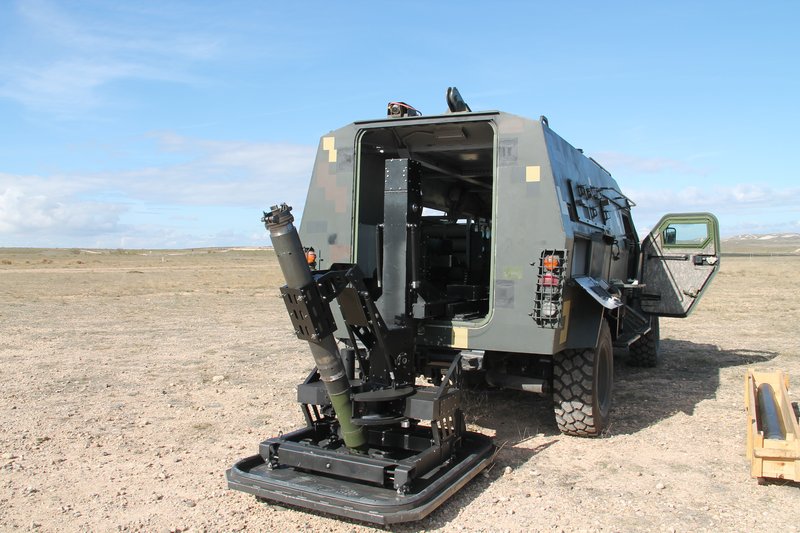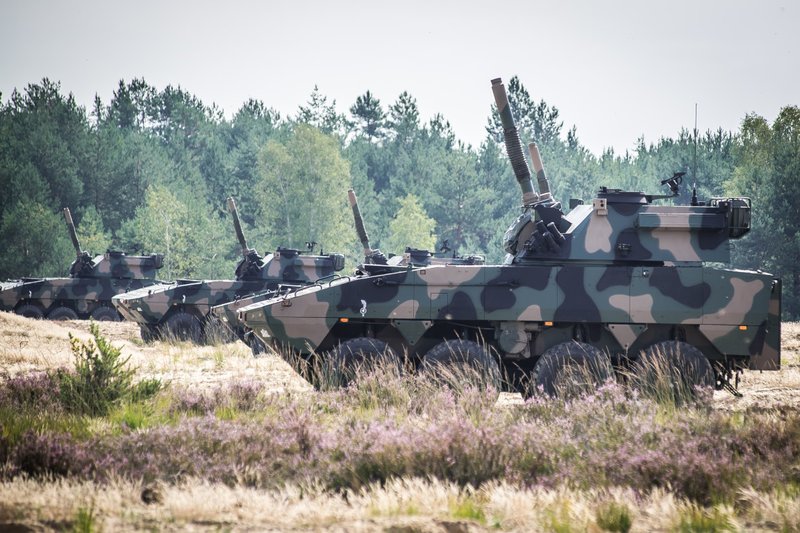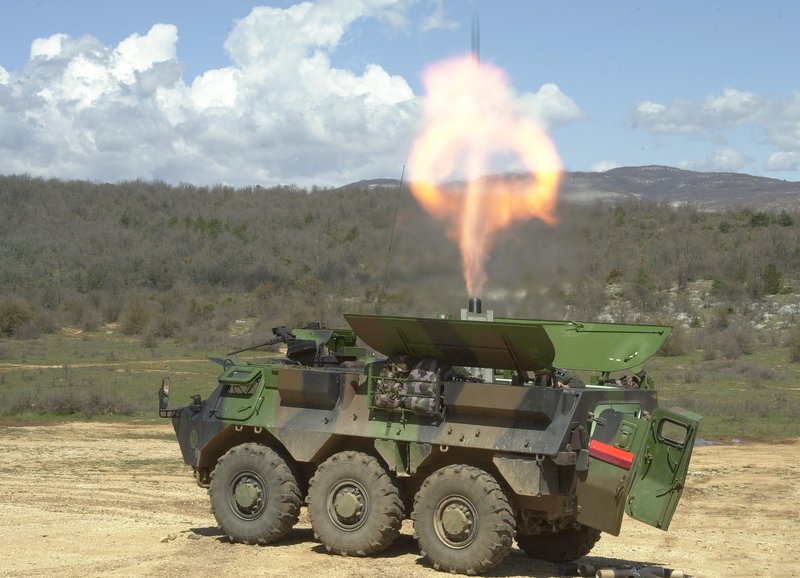Why the mortar is enjoying a renaissance
While there has been blanket coverage of the deployment and use of conventional tube artillery and rocket systems in the conflict in Ukraine, mortars have also been used in large numbers by both sides. Indeed, analysis has shown that around 80% of battlefield casualties are caused by these fires combined.
I recently chaired the Future Mortars Conference in London which gave an opportunity to see what some armies and developers are looking at to enhance the capability of such systems... Continues below
Newsletter Sponsors:

Above: The Spanish Alakran 120mm system integrated on a Bars-8 4x4 APC (as supplied to Ukraine) is a prime example of an ‘over-the-rear’ mortar fitted to a relatively light chassis. (Photo: author)
In addition there was time to talk to countries and contractors who, while not giving presentations, did lift the lid on what they were working on.
There were a number of themes that came out of the event, including extending the life of existing systems, the move to install mortars on much lighter platforms, and the shift to turret-mounted mortars and advanced weapons that fire though open hatch covers.
A good example of a potential mortar upgrade is the US Army which is looking to enhance its currently deployed 81mm and 120mm systems to improve firepower and survivability.

The currently deployed M252 81mm mortar will be integrated onto a 4x4 vehicle and deployed over the rear when required, reducing in- and out-of-action times.
The in-service M252 uses the M253 barrel which is of steel alloy and gives a maximum range of up to 5,900m using a high-explosive (HE) mortar bomb.
This will be replaced by a new enhanced barrel that is longer and made of high temperature alloy. Fitted with a removable blast attenuation device, this will enable a new HE Extended Range (ER) bomb to be fired to a maximum range of 8,000m.
The current US Army 120mm mortar could also be integrated on a 4x4 for greater survivability against counter-battery fire.
A number of countries have already deployed 120mm mortars on this kind of light platform with a good example being the Spanish Alakran, which is in service with Saudi Arabia integrated on a Toyota Land Cruiser and in Ukraine on the Bars-8 4x4 APC.
Other articles in this newsletter:
Powering up: inside the new engine that could drive next-generation US Army combat vehicles
Can Serbia find a market for upgraded Soviet artillery?
At AUSA 2023 the Alakran was also shown integrated on the MRZR Alpha 4 with the complete package being called the Scorpion Mobile Mortar Weapon System. The second Alakran option displayed at that show was aboard a Flyer 4x4 which was also fitted with a remote weapon station (RWS) armed with a .50cal MG and associated radars for engaging UAVs.
Meanwhile, at the Partner 2023 exhibition in Belgrade, the Semy 120M mortar was shown in prototype form on a Zastava 4x4 chassis, again deployed over the rear. A total of 40 120mm mortar bombs are carried which have a maximum range of 6,200m.
And at DSEI 2023 ST Engineering showed the first example of its 120mm Ground Deployed Advanced Mortar System (GDAMS) integrated of the rear of a four-door Toyota Land Cruiser. The Jordan Design & Development Bureau has also integrated the US 81mm M252 mortar on the Land Cruiser with the complete system called the Al Tareq.
With every major trade show this year seemingly featuring a new 4x4/mortar combination, it is possible that not all will see operational service. It is too early to say which will succeed in what looks like a crowded market.

Turning to turret-mounted mortars, these are by no means new as Russia has deployed the tracked 120mm 2S9 Anoa for many years based on the BMD airborne assault vehicle. More recent equivalents are the 2S23 NONA-SVK based on the BTR-80 APC and 2S31 Vena based on a much modified BMP-3 IFV chassis.
Russia has also deployed a 120mm laser-guided mortar projectile and these turret-mounted mortars have a direct fire capability using high-explosive antitank (HEAT) rounds.
A number of other countries are now looking at the acquisition of turret-mounted mortars including Germany, the UK and US.
In terms of readily available options, the Patria twin 120mm AMOS (Armoured Mortar System) was originally developed to meet the requirements of Finland and Sweden but the latter subsequently pulled out.
A total of 18 AMOS (14 new plus four upgraded prototypes) were subsequently supplied to the Finnish Defence Forces installed on the Patria Armoured Modular Vehicle (AMV) 8x8 APC.
Patria subsequently developed, using private funding, the 120mm NEMO (NEw MOrtar) which at around 1,900kg is much lighter than the twin AMOS.
The first 36 were supplied to GDLS Canada for installation on LAVs for Saudi Arabia, while the UAE took delivery of a batch of NEMO turrets for installation on coastal patrol craft.
More recently, Sweden also placed a contract for eight coastal craft which will be fitted with NEMO turrets as this has a proven on-the-move fire capability while afloat. NEMO can be used for direct fire missions and has a multiple-round simultaneous impact (MRSI) function.
When Sweden pulled out of AMOS it had already ordered 40 CV90-series chassis from BAE Systems Hägglunds which were subsequently stored. In the end these were fitted with a 120mm twin muzzle-loaded mortar turret called Mjolner.
More recently two additional batches of 20 were ordered to bring the total up to 80 units. The Mjolner turret has a limited traverse of 90 degrees left and right and is not currently fitted with a computerised FCS.

Above: The Polish RAK 120mm turret-mounted mortar system is based on the Rosomak 8x8 platform, which is a Patria AMV optimised to meet local requirements. (Photo: HSW)
Poland meanwhile has now fielded over 100 of its RAK 120mm turret-mounted mortar systems based on a locally manufactured Finnish AMV chassis, the Rosomak. Poland took a systems approach, with the programme covering ammunition and command posts as well as the RAK turret.
Elbit Systems’ latest development in this field is the 120mm Light Mortar Turret (or Crossbow as it is also known) which was unveiled earlier in 2023; development is expected to be completed late in 2024.
With the aforementioned major procurements on the horizon, one or more of these systems could be in for a substantial order book boost.
Naturally, 81mm and 120mm mortars firing through hatches are not new but in the past these were simple systems with no FCS and manual controls. A number of more advanced 120mm options have now been developed and put in production.
RUAG’s turntable-mounted 120mm Cobra mortar for example is a further development of the earlier Big Horn and features all-electric elevation and traverse, A computerised FCS, A load assist device and a navigation system.
The first customer was Oman, operating the system integrated onto a Turkish FNSS Pars III 8x8 APC and more recently the Swiss Army has placed two orders for 32 units, subsequently increased to 48, with GDLS MOWAG acting as prime contractor and systems integrator. The Cobras are integrated into a Piranha 3.5 vehicle.
The competing Thales 120mm 2R2M rifled mortar was developed as a private venture over 20 years ago and uses the same rifled barrel as the equivalent towed mortar which has been sold to over 20 countries.
The 2R2M is a turntable-mounted system with electric traverse and elevation and a computerised FCS.
It has now been selected by the French Army which will install the system in 54 of its Griffon 6x6 APCs, although the 2R2M is already in service with a number of other countries including Italy, Malaysia, Oman and Saudi Arabia.

Above: A French VAB 6x6 APC fitted with Thales 120mm 2R2M rifled mortar firing through open roof hatches. (Photo: Thales)
EXPAL of Spain (now owned by Rheinmetall) meanwhile has developed and placed in production the Integrated Mortar System 60mm/81mm (EIMOS) which is typically installed on a light vehicle such as the URO VAMTAC ST5 4x4. The 81mm version is already deployed by Bahrain and Spain.
Rheinmetall Norway is now marketing the turntable-mounted Ragnarok mortar which weighs less than 1,500kg and is coupled to a fully automated aiming system powered by VINGPOS software, which displays the graphical aiming point.
Unlike other similar mortars it does not have a load assist device to keep it as simple as possible, and according to Rheinmetall Norway NS most 120mm barrels can be fitted. A trailer-mounted version has also been developed to the prototype stage.
Turkey has rolled out a number of new mortar systems with the first to enter service being the Aselsan 120mm integrated into the rear of a BMC 4x4 MRAP platform.
The mortar still has its place on the modern battlefield, and many armies are in the market for the latest highly mobile systems with advanced fire control and direct fire capability.
Don't want to miss out on future Decisive Edge content? Make sure you are signed up to our email newsletters.












